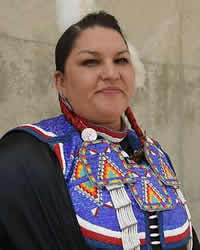The Dakota are one of the three main divisions of the Sioux Nation, which includes the Dakota, Nakota, and Lakota peoples. The Dakota themselves are divided into four primary bands: Mdewakanton, Wahpekute, Wahpeton, and Sisseton. They originally inhabited the upper Mississippi River region, in what is now Minnesota, Wisconsin, and surrounding areas.
The Dakota language, part of the Siouan language family, is still spoken among elders and in revitalization programs, though English is dominant in most daily life. Historically, the Dakota lived by hunting, fishing, and gathering, and they maintained a complex social, spiritual, and political life centered on kinship, oral tradition, and respect for nature.
In the 19th century, the Dakota faced a series of displacements due to treaties, land loss, and the U.S. government's failed promises. The Dakota War of 1862 in Minnesota led to mass executions, internment, and the forced removal of many Dakota from their homelands. The Lakota Sioux have the distinction of being the last tribe conquered by the U.S. at Wounded Knee in 1890. Today, Dakota communities are located primarily in Minnesota, Nebraska, North and South Dakota, and Montana, with some bands on reservations and others in urban areas. A small number live further north in Canada.
Modern Dakota people live in a range of settings—from rural reservations to urban cities. Many Dakota families maintain strong community and cultural ties through ceremonies, language programs, and powwows. Tribal governments oversee services such as education, housing, and health care. Several tribes operate economic ventures like casinos, tourism businesses, and cultural centers.
Despite progress, Dakota communities often face persistent challenges. These include poverty, unemployment, addiction, mental health issues, and intergenerational trauma linked to historical injustices. Many youth struggle to balance modern life with traditional identity. Yet there is resilience, with growing movements toward language revitalization, cultural healing, and indigenous-led education initiatives.
Traditionally, Dakota spirituality is centered on Wakan Tanka, the Great Spirit, and a sacred, interconnected view of the world. Ceremonies like the Sun Dance, sweat lodge, vision quests, and pipe rituals are central to their spiritual life. Dreams, visions, and ancestral guidance are respected as vital forms of wisdom.
With the arrival of Christian missionaries in the 1800s, many Dakota people were introduced to Christianity, and some converted, particularly to Catholicism and Protestant denominations. Today, a significant number of Dakota identify as Christian, yet many also hold on to or return to traditional beliefs and practices. In many communities, traditional spirituality and Christianity exist side by side or in blended forms.
Though the gospel has been present among the Dakota for generations, not all have had access to culturally relevant discipleship or Christian community.
The Dakota people need continued healing from historical trauma, poverty, and systemic injustice. Culturally responsive education, economic opportunities, and mental health support are critical needs in many communities. Language and cultural revitalization are also urgent, as younger generations risk losing vital aspects of their heritage.
Spiritually, there is a need for indigenous Christian leaders who can walk faithfully in both biblical truth and Dakota identity. Many Dakota have heard the gospel, but few have seen it deeply contextualized in a way that respects their culture and answers their spiritual questions. There is a hunger for wholeness, purpose, and hope that only Christ can fully satisfy, but it must be shared with humility, honor, and relational trust.
Pray for an increase in discipleship and outreach resources in the Dakota language.
Pray that the substantial amount of Dakota that are lost in traditional religion would be stirred to repentance and faith in Christ by the Holy Spirit.
Pray that the Dakota people would find their healing and hope in Jesus Christ.
Pray that the hearts of the Dakota people would be open and see clearly that the true identity of the Great Spirit is Yahweh of the Bible.
Pray that indigenous Christian leaders would shepherd Dakota believers to be rooted in the Scriptures and develop into loving and compassionate evangelists to their own people.
Scripture Prayers for the Dakota, Sioux in United States.
Dakota Wicohan Language and Cultural Revitalization Organization — https://www.dakotawicohan.org
Native Languages of the Americas – Dakota Language — http://www.native-languages.org/dakota.htm
Minnesota Historical Society – U.S.–Dakota War of 1862 — https://www.usdakotawar.org
Smithsonian National Museum of the American Indian – Dakota Resources
| Profile Source: Joshua Project |











